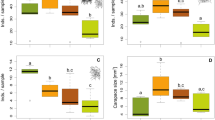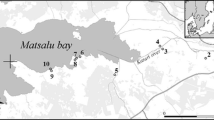Summary
In the Nylsvley Nature Reserve, in the South African savanna, the spider community in 320 abandoned mammal burrows was investigated. Three species, Agelena ocellata (Agelenidae), Euprosthenops proximus (Pisauridae) and Smeringopus pallidus (Pholcidae), coexisted in the burrows. The number of individuals and the number of species inhabiting the burrows increased with burrow size. Gerbil burrows were apparently too small to provide space for more than one individual of any of the three species. Only the burrows of springhares, warthogs, and antbears contained more than one spider. When artificial burrows were provided a rapid increase in settlement resulted. Competition for space therefore seems to be the determining factor influencing the population size. A relatively low number of prey items (136, in 119 webs) were found in agelenid webs only. Kleptoparasitic ants were observed stealing prey items from the webs.
Similar content being viewed by others
References
Lehtinen PT (1967) Classification of the cribellate spiders and some allied families, with notes on the evolution of the suborder Araneomorpha. Annales Zoologici Fennici 4:1–468
Millot J (1940) Les araignées de l'Afrique occidentale français. Memoires de l'Academie des Sciences de l'Institute de France 64:1–50
Riechert SE (1978) Energy-based territoriality in populations of the desert spider Agelenopsis aperta (Gertsch). Symposium of the Zoological Society of London 42:211–222
Rypstra AL (1983) The importance of food and space in limiting web-spider densities, a test using field enclosures. Oecologia 59:312–316
Schaefer M (1978) Some experiments in the regulation of the population density in the spider Floronia bucculenta (Araneidae, Linyphiidae). Symposium of the Zoological Society of London 42:203–210
Vollrath F (1987) Kleptobiosis in spiders. In: Ecophysiology of Spiders, Springer Berlin Heidelberg New York, pp 274–286
Wise DH (1981) Inter- and intraspecific effects of density manipulations upon females of two orb-weaving spiders (Araneae, Araneidae). Oecologia 48:252–256
Wise DH, Horton CC (1983) The experimental analysis of competition between two syntopic species of orb-weaving spiders (Araneae, Araneidae). Ecology 64(4):929–944
Wise DH (1983) Competitive mechanisms in a food-limited species: relative importance of interference and exploitative interactions among labyrinth spiders (Araneae, Araneidae). Oecologia 58:1–9
Wise DH (1984) The role of competition in spider communities: insights from field experiments with a model organism. In: Ecological communities: Conceptual issues and the evidence. Princeton University Press: 42–53
Author information
Authors and Affiliations
Rights and permissions
About this article
Cite this article
Heidger, C. Ecology of spiders inhabiting abandoned mammal burrows in South African savanna. Oecologia 76, 303–306 (1988). https://doi.org/10.1007/BF00379968
Received:
Issue Date:
DOI: https://doi.org/10.1007/BF00379968




